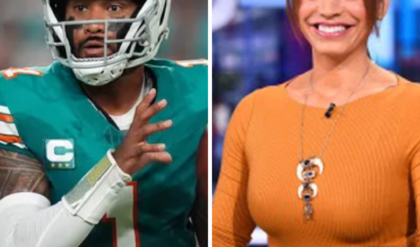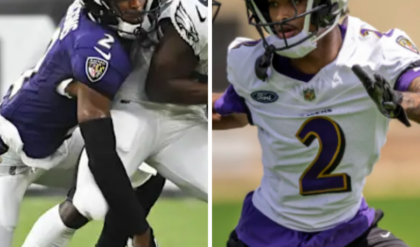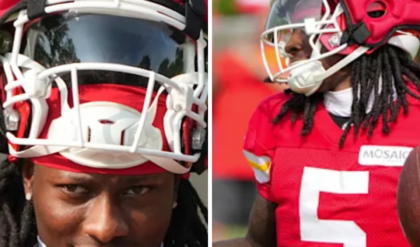Chicago Bears General Manager Ryan Poles speaks during a news conference at Halas Hall in January 2022. (Nam Y. Huh/AP)
The Chicago Bears received the NFL draft’s first pick this winter in miraculous fashion. The Houston Texans, down by seven with less than a minute left in their season finale against the Colts in Indianapolis, scored a 28-yard touchdown on fourth and 20, then completed the two-point conversion. The victory pushed Houston to 3-13-1, and suddenly, the Bears’ 3-14 record was the worst in the NFL. In Chicago, a wretched season had become a rainbow with a pot of gold at the end, a prize hard-earned through misery.
“When you stink on the field on Sundays, that reward in April is to get to sit there and say, ‘We have a chance to get the best player in the draft,’” former Tennessee Titans director of scouting Blake Beddingfield said.
On Friday, the Bears became a rare exception: They stunk on Sundays, and they were willing, even eager, to let somebody else pick the best player in the draft. Chicago shipped the first pick to the quarterback-needy Carolina Panthers for the ninth pick in this year’s draft, a 2024 first-round pick, wide receiver D.J. Moore and two additional draft choices.
General Manager Ryan Poles had told reporters at this month’s league scouting combine that the Bears were considering trading the first pick, a signal of his intention to turn one of the most powerful assets in the NFL into a haul that, in Poles’s vision, could make the Bears a contender.
“As a front office person, it’s a bit of a dream in terms of the flexibility and options that you have to improve the football team,” Poles said.
The trade placed the Bears on a short list — only two teams had dealt the top pick in the 2000s. Before the Los Angeles Rams moved up in 2016 and took Jared Goff with the selection they acquired from the Titans, no team had traded the first pick since the San Diego Chargers swapped with the Atlanta Falcons, who picked Michael Vick first in 2001.
The dearth of recent trades involving the first pick exists for myriad reasons. When the 2011 collective bargaining agreement heralded a rookie salary scale, teams no longer had financial incentive to trade the top pick if they wanted to avoid a costly negotiation. And though many NFL draft trades have become simplified as analytical insights have led teams to place roughly the same value on draft picks, the first pick is unique, valued differently depending on the year. On top of all that, trading the first pick requires ownership to pass on a marketing windfall, and it means a front office, after enduring a painful season, risks bypassing a singular talent.
“I think teams are afraid — a little fear comes into passing up a great player,” said Beddingfield, who was part of the Titans front office that traded the No. 1 pick in 2016. “When you have a Myles Garrett or a Trevor Lawrence, you’re afraid to pass up those elite-level talents and try to acquire more players. You really have to have those elite players to win that ultimate last game of the season.”
Some years, the best prospect is so obviously gifted, a team has no choice but to select him. Other years, there is no clearly elite prospect, which means rivals will have no appetite for sacrificing the capital to acquire the first pick. And often, the team holding the first pick nosedived in the fall because it lacked a quarterback, and it will talk itself into drafting its favored passer even if there is no consensus top choice.
The Bears’ roster and the 2023 draft class created the cocktail of factors required for a team to trade the first pick. Chicago, having drafted Justin Fields in 2021 and watched him flash enormous potential last season, is the rare last-place team with a settled and promising quarterback situation. The Bears might have been tempted to trade Fields if one of the top quarterbacks — Bryce Young, C.J. Stroud, Anthony Richardson and Will Levis — were regarded as a generational prospect, but all have clear flaws or question marks. Still, they’re tantalizing enough for Carolina to value having the Bears’ choice at the top of the draft.
In 1997, Bill Parcells never had the chance to make that kind of decision. He had just become head coach and general manager of the New York Jets, who had gone 1-15 in 1996. He quickly decided the Jets had so many needs that he would better off turning one pick into several — with one catch. Peyton Manning was a junior at Tennessee, and he had been the presumed first pick before he decided to return for his senior season.
“Had Peyton Manning come out in the draft, which he elected not to do, probably would have been a different story,” Parcells said. “Since he didn’t come out, we had several needs, and we did have a veteran quarterback in Neil O’Donnell. I felt like if we could get multiple picks, it would be to our benefit.”
That spring, the Jets traded down not once, but twice. The St. Louis Rams sent the Jets their first-round pick (No. 6) and three others to move up and take tackle Orlando Pace. The Jets then dealt the No. 6 pick to the Tampa Bay Buccaneers for the eighth pick and a fourth-rounder. Parcells kept dealing until he had turned the first pick into eight players.
The Jets’ outcome in 1997 illustrates the downside the Bears now face. The Jets filled their roster and within two seasons became a contender. But both Pace and Walter Jones, the tackle eventually taken sixth, made the Hall of Fame. Parcells did not doubt his process, arguing that quantity in the draft has a better track record than predicted quality.
“Theoretically, you ought to be able to take the best player in the country if you have the first pick,” Parcells said. “That hasn’t turned out to be true, retrospectively. In some cases, it’s true. There have been many of them it didn’t turn out that way. It just on who’s doing the picking and what they see. They don’t sell insurance for it, I can tell you that.”
‘A sweet deal’
Poles is starting his second year as Chicago’s general manager, and his recent arrival may have factored in his willingness to part with the first pick. The last three general managers to trade the first pick — Parcells, the Titans’ Jon Robinson and the Chargers’ John Butler — were each in their first year on the job. The move builds runway, adding future picks. A general manager at the outset of his contract believes with a fair degree of certainty he will use those picks, not hand them to a replacement.
Rams General Manager Les Snead and then-coach Jeff Fisher stand onstage with quarterback Jared Goff and his family after the team introduced the No. 1 pick in April 2016. (Victor Decolongon/Getty Images)
In 2016, Robinson took over a franchise that had drafted Marcus Mariota second the year before. Beddingfield recalled preparing as if the Titans would use the first pick; he determined cornerback Jalen Ramsey was the draft’s best player.
But at the combine, with Carson Wentz and Goff atop most evaluators’ quarterback rankings, Robinson informed teams the Titans would be willing to discuss the first pick. The Rams emerged as the primary suitor.
Share this articleShare
“We had been stuck in quarterback purgatory for many years,” Rams COO Kevin Demoff said. “There was no player who had taken us to the next level, but we hadn’t been bad enough to get up into the draft and pick high enough to find that quarterback.”
No team matched the Rams’ enthusiasm to trade, Beddingfield said, but the sides still needed to determine compensation. The Rams held the 15th pick, which meant “they really had to make it a sweet deal” compared to what they’d have been able to offer if they had been slated to choose closer to the top of the draft, Beddingfield said. When they agreed to deal their two second-round picks, the trade came together. The Rams sent the 15th pick, the two second-rounders, a third-round pick, a 2017 first-round pick and a 2017 third-round pick for the first pick.
The Titans used one of the Rams’ second-round picks to select running back Derrick Henry, who went on to be the best offensive player on teams that reached an AFC championship and earned a No. 1 playoff seed. Beddingfield, though, regretted one piece of their maneuvering: The Titans ended up trading back up to eighth, where they picked right tackle Jack Conklin, a solid player whom they let walk after four seasons, owing to the salary scale at his position not matching what a fifth-year rookie option pays. If the Titans were going to trade back up, Beddingfield thinks now, they should have moved high enough to take their favored player.
“I would have liked to traded out of that pick and moved back up to select the No. 1 pick in the draft, in my opinion, in Jalen Ramsey,” Beddingfield said. The Jaguars took Ramsey when he slid to fifth.
Michael Vick declares for the 2001 NFL draft as his mother, Brenda Boddie, and Virgina Tech Coach Frank Beamer sit nearby. (Steve Helber/AP)
‘We can’t give away our whole draft’
In 2001, Michael Vick was the clear-cut best prospect available, a quarterback with an unprecedented blend of speed and arm strength. As the draft approached, though, the Chargers’ contract negotiations with Vick stalled. Butler hatched an alternative plan: He wanted running back LaDainian Tomlinson and Drew Brees, his second-rated quarterback.
Meanwhile, in Atlanta, the Falcons considered a move up from the fifth pick. Ron Hill, Atlanta’s vice president of personnel, arranged a meeting between Dan Reeves, the Falcons’ coach, and Frank Beamer, Vick’s college coach at Virginia Tech. Hill brought Vick to the Falcons’ facility to meet with Reeves.
“Dan was the key in us making this trade, as far as the Falcons were concerned,” Hill said. “It was for him to convince himself this was the right move for the franchise and he could coach this kid. He came out of the room and said, ‘I could do this.’ My feeling was, [Vick] had so much versatility, he’s going to make you a better coach, because he’s going to get you thinking more about what you’re doing on offense. He can do so many things with his physical traits.”
Two days before the draft, Hill spoke with the Chargers for the first time. He and Butler had a cordial relationship, and talks moved swiftly. Butler asked for the fifth pick and Atlanta’s second- and third-round choices, plus wide receiver Tim Dwight.
“I told [Butler], ‘Hey, we’re not one guy away here. We can’t give away our whole draft for just one guy,’” Hill said. “So I said, ‘Why don’t you let me keep the [second-round] pick, and we’ll give you that pick next year?’ His answer was, ‘Huh, that works for me. That’s okay. We’ll do that.’”
Michael Vick gestures to Falcons fans as he announces Colorado’s Isaiah Oliver as the team’s pick during the second round of the 2018 NFL draft. (Eric Gay/AP)
Vick immediately became one of the most exciting players in the NFL and showed one of the extra benefits of acquiring the first pick: It excites a fan base like few other things can. “He filled that stadium pretty quick,” Hill said. “At that time … we were having a hard time filling the stadium, even though we’d had some success with [Chris] Chandler and [going to] the Super Bowl. This kid solved a lot of problems for us.”
The Chargers, just as they intended, took Tomlinson fifth and used their own second-round pick to take Brees. They had read the board perfectly.
The Bears had to evaluate multiple possibilities with incomplete information before agreeing to Friday’s trade. Earlier this month, Beddingfield said the Bears would need to forecast the 2023 results for all their potential trade partners, because those results will determine where a 2024 first-round pick lands — the value of their trade haul is now directly tied to Carolina’s 2024 success. They also needed to assess the 2024 draft to determine how valuable future picks could be.
That is one of the costs of trading the first pick. The Bears not only traded the hypothetical best player. They also lost, and gave the Panthers, certainty in an uncertain endeavor.
“The only way you know you’re going to get the guy you want,” Hill said, “is to go get the first pick.”









